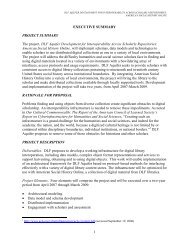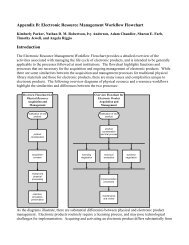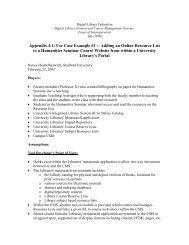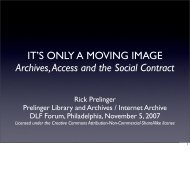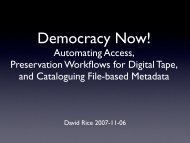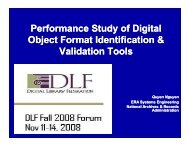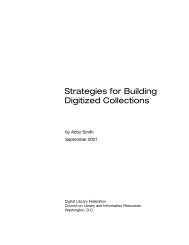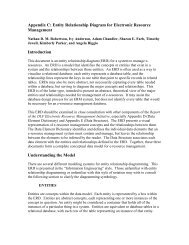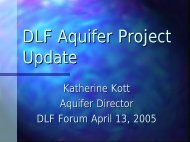Functional Requirements for Electronic Resource Management
Functional Requirements for Electronic Resource Management
Functional Requirements for Electronic Resource Management
You also want an ePaper? Increase the reach of your titles
YUMPU automatically turns print PDFs into web optimized ePapers that Google loves.
Benefit Test <strong>for</strong> AMP expenses:13. The entire issue regarding adjustment on account of the arm's length price of AMP expenses isfounded on the contention that such expenses incurred by the domestic enterprise using or exploiting a<strong>for</strong>eign trademark and/or logo in India, resulted in a benefit or creation of marketing intangibles <strong>for</strong> theoverseas associated enterprise owning such trademark and/or logo.14. The benefit of expenses on advertisement and sales promotion, etc. inure to the domestic enterprisewho is entitled to exploit trade mark in India. Being an exclusive distributor in India of the products ownedby the <strong>for</strong>eign AE, the benefit of AMP expenses inures to the domestic enterprise in the <strong>for</strong>m of higher salesand consequently higher profits and if there is any benefit which incidentally inures to the overseasassociated enterprise, it cannot be contended that marketing services have been per<strong>for</strong>med by the Indiandistributor. The expenses on advertisement and brand promotion are not incurred at the instance ordirection of neither the AE nor the AE is to benefit from such expenditure incurred by the domesticenterprise in India.15. It has been the consistent position of the Courts including the Supreme Court that so long as theassessee derives direct advantage / benefit from expenditure incurred by it (on advertisement andpromotion), no adverse inference is to be made even if any direct or indirect benefit which might haveinured to the parent company owning that trademark and/or logo. [refer 30 ITR 601 (SC); Sassoon J. Davitand Co. P. Ltd. vs. CIT : 118 ITR 261 (SC); Sony India (P) Ltd vs. Dy.CIT : 114 ITD 448 (SB) (Del); StarIndia (P) Ltd. : 103 ITD 73 TM (Mum.); National Panasonic (India) Ltd. vs. JCIT : ITA No.3238/Del/2002; Samsung India (order dt: 28-11-2008 in ITA No. 3360 & 3734/Del/02); Nestle India Ltd.vs. DCIT : 111 TTJ 498 (Del) (affirmed by the Supreme Court)].16. The AMP expenses are incurred by a domestic enterprise in the course of carrying on of its businessin India. Such AMP expenditure are neither incurred at the instance of overseas associated enterprise, northere is a mutual agreement or understanding or arrangement as to allocation or contribution towardsreimbursement of any part of AMP expenditure incurred by the domestic enterprise <strong>for</strong> the purpose of itsbusiness. In absence of any understanding, arrangement, etc., no 'transaction' or 'international transaction'could be said to be involved with respect to such AMP expenditure incurred by the domestic enterprise,which may be covered within the ken of Transfer Pricing regulations.17. In absence of any “transaction” which results in transfer of the benefit of AMP expenses whichotherwise belong to and is exploited by the domestic enterprise to the associated enterprise, the question oftransfer of the marketing intangibles or payment by the AE to domestic enterprise <strong>for</strong> transfer of suchintangibles does not arise, so as to embark on a benchmark exercise.18. Also, under the Income-tax Act and particularly under the Transfer Pricing regulations, at presentthere is no concept of creation of marketing intangibles or recognizing such an asset which allegedly mayhave resulted by virtue of extra ordinary AMP expenses unilaterally incurred by domestic enterprise incourse of carrying of its business in India.164
14.1. store vendor-supplied primary and secondary URIs (e.g., <strong>for</strong> mirror sites) used<strong>for</strong> access to the resource14.2. support the creation, storage, and updating of persistent URIs and/or integrationwith external systems <strong>for</strong> managing persistent identifiers14.3. support authentication and access systems (such as proxy servers or statisticsgeneratingscripts), allowing <strong>for</strong> URIs to be constructed on the fly on the basis ofstored data elements14.4. generate notifications and/or exports of URI in<strong>for</strong>mation to appropriate linkedor external systems according to local requirements (e.g., notification or export tocataloging and in<strong>for</strong>mation technology departments or systems)14.5. provide seamless functional integration with external systems that record thisin<strong>for</strong>mation (e.g., through a shared pointer);15. Integrate proxy server/access management with other functionality15.1. provide a means <strong>for</strong> seamless integration of proxy server access <strong>for</strong> all orselected users and all or selected resources;16. Store lists of IP addresses used to register access to specific resources and provideautomated e-mail notification to online providers when IP addresses are updated,16.1. support the creation and maintenance of multiple lists of IP addresses that canbe associated or disassociated with one or more licensed locations and linked toone or more bibliographic entities16.2. <strong>for</strong> a given resource or online provider, indicate whether IP addresses are/wereregistered online and record the registration URI16.3. send automated e-mail notifications to vendors and providers when IP addressesare updated and record the date on which notifications are sent. Include theability to record an acknowledgment date. This implies the ability to designate avendor or provider contact address <strong>for</strong> IP address-notification purposes;17. Store one or more user IDs and passwords and provide the ability to generate securescreen displays of this in<strong>for</strong>mation <strong>for</strong> authorized users and staff, with associated textor <strong>for</strong> JavaScript autosubmission; and18. Implement access restrictions,18.1. record authorized user categories and authorized sites, including the ability toassociate specific actions with those elements, such as:18.1.1. generating staff and user displays18.1.2. implementing access controls18.1.3. exporting in<strong>for</strong>mation to a local access-management system (technicalsystem in use at your institution such as an authentication system and/orproxy server (see also <strong>Resource</strong> Administrative and <strong>Management</strong>Functions).
STAFF REQUIREMENTSStaff InterfaceAn ERM system requires a staff interface that enables library staff to efficiently carry outthe work described in the sections that follow. The interface should be organized intoviews that are optimized <strong>for</strong> particular areas of staff activity or interest, such as resourceacquisition, troubleshooting, license administration, or administration and statistics.Details of appropriate interface design are not addressed in these requirements; these areleft to the art and discretion of system developers.Through this interface, staff should be able to:19. Search, browse, and retrieve records by attributes unique to e-resources, such aslicense, vendor, interface, record status, licensed site, consortium, and library selectoror other local contact individual;20. View the full range of in<strong>for</strong>mation appropriate to the staff member's security profileand functional role;21. To the extent possible, link to other relevant in<strong>for</strong>mation stored in librarymanagement systems, portals, or related systems; and22. View records that are hidden from the public.Selection and Evaluation ProcessDuring the selection and evaluation process, it is typically necessary <strong>for</strong> a decentralizedgroup of individuals to coordinate a complex and iterative series of steps. The ERMsystem should provide support <strong>for</strong> recording actions at each of these steps and be capableof per<strong>for</strong>ming specified actions upon completion of a given task and of sending alertswhen anticipated actions do not occur.A typical selection and evaluation process might involve the following steps and requirethe following reminders and notifications, all built from stored action dates and locallydefinable status fields:• Build request record <strong>for</strong> trial;• Flag resource as trial;• Notify interested parties that trial is live and provide the access instructions andexpiration date (triggered by trial start date and e-mail address[es] input into requestrecord);• Allow staff (and, optionally, users) to access the trial via stored URL;• Send reminder to those notified of a trial that expiration date is near (triggered by trialend date and e-mail address[es] input into request record);• Record opinions of key players and final purchase decision, allowing <strong>for</strong> both centraland local input of opinions and funding commitments into notes fields in requestrecord;
• Prompt licensing/acquisitions contact to report purchase decision (triggered bydecision date input into request record). The most common options are “Approve,”“Reject,” or “Put on Hold”; and• For resources that are approved <strong>for</strong> purchase, additional statuses and actions would berequired, including• notify licensing contact to obtain and negotiate license, and remind this contact iflicense is not completed by a given deadline (triggered by stored licensingcontact, notification of approved status, and deadline input at time of approval)• notify access contact if status has not changed to “live” by deadline (triggered byinputting likely access date into system at time of approval)• notify cataloging and selector/product sponsor, as well as other interested parties,when access is available (triggered, <strong>for</strong> example, by changing status to “Live” andby stored e-mail address[es] related to this purchase).The companion <strong>Electronic</strong> <strong>Resource</strong> <strong>Management</strong> Workflow Flowchart provides adetailed diagrammatic view of workflow decision and action points (see Appendix B).To support these processes, it should be possible to:23. Create provisional records <strong>for</strong> resources that may or may not be permanently acquiredand track the selection and evaluation process through acquisition or rejection;24. Assign locally definable status fields to request records and associate particularactions with those statuses. Examples of such fields include “New Request,” “OnTrial,” “Trial Expired/Decision Pending,” “Approved,” “Rejected,” and “On Hold”;25. Assign locally definable fields to request records <strong>for</strong> license routing and status andassociate particular actions with those fields. Site should be able, <strong>for</strong> example, todefine a list of individuals from whom sign-off is required, send reminders to licensereviewers, and record approval or rejection status, with notes;26. Assign multiple local contact individuals and site-defined roles to both requestrecords and permanent resource records;27. Send e-mail notifications to individuals designated as local or licensing contacts;28. .Make trial resources available in a secure manner through the library’s resource toolof choice to authorized users (if wanted) and staff28.1. store trial URIs and passwords and make these available, securely if necessary28.2. flag items unambiguously as trial resources, with associated public and staffnotes28.3. record a trial expiration date and, optionally, send an alert to designatedrecipients n days prior to trial expiration;
29. Record a decision due date and, optionally, send an alert to designated recipients ndays prior to decision date;30. Establish a site-defined routing workflow <strong>for</strong> resources that are approved <strong>for</strong>purchase. For example, it should be possible to send notifications to designated staf<strong>for</strong> departments or to place resources in a queue <strong>for</strong> further action by those units totrigger actions such as the placing of an order, completion of cataloging, andimplementation of access management by designated staff; and31. Purge rejected records from the system, sequester into a history archive, or retainsuch records with notes about the decision process (including a link to writtenevaluations if wanted), at the library’s discretion.<strong>Resource</strong> Administration and <strong>Management</strong> FunctionsThe functions described in this section pertain to activities required to fulfill licenseobligations and to administer and support resources that have been acquired. Some of thedata and functions pertain to the license itself, while others pertain to the management ofindividual resources. The system should be able to record data at the most efficient levelrequired to avoid redundancy, relying on the relationships among entities to make thein<strong>for</strong>mation available at other applicable levels (e.g., individual resource, package, orinterface).It should be possible to:32. Store license rights and terms <strong>for</strong> reference, reporting, and control of services32.1. <strong>for</strong> services including, but not limited to, interlibrary loans, reserves, distanceeducation, course Web sites, and course packs,32.1.1. identify whether a given title may be used <strong>for</strong> the service and under whatconditions32.1.2. generate reports of all materials that may or may not be used <strong>for</strong> theservice with notes about under what conditions, and32.2. include a mechanism <strong>for</strong> adding new services, allowing staff to specify thename of the service and associated actions such as public displays, reports, andalerts;33. Record the categories of users and sites that are authorized <strong>for</strong> access to a givenresource and generate displays <strong>for</strong> end users and staff on the basis of this in<strong>for</strong>mation(see also Access <strong>Management</strong> <strong>Requirements</strong>);34. Support breach investigation and cure activities and other activities that may berequired to fulfill license obligations
34.1. record the cure period <strong>for</strong> breach and generate alerts at library-specifiedintervals on the basis of this in<strong>for</strong>mation when a breach has been reported34.2. provide a breach-incident log in which to record reports of alleged breachingactivity, including date and source of initial report, open/closed status, resolutiondate, and actions taken. This should have the capability of generating reports oncommonalities of breaches (e.g., type of breach, department showing regularbreaches)34.3. include a mechanism <strong>for</strong> adding fields in which to record unusual compliancerequirements that the library may want to track, including implementation statusand date and the ability to generate reports or alerts on the basis of thisin<strong>for</strong>mation. Examples might include a requirement to post notices to end usersor to destroy locally held copies upon termination (see also TerminationActivities);35. Record additional license terms and metadata <strong>for</strong> contract management and auditingpurposes, such as license commencement date, duration of agreement, confidentialityprovisions, and other site-definable key terms;36. Provide the ability to display or link to an online version of a license agreement;37. Manage the library's archival rights in electronic content,37.1. record whether permanent rights to the year level exist in a given resource and,if so, their source, dates of coverage, manner of execution, and the applicablelicense through which rights are provided. It should be possible to associatemultiple archival field clusters with a given resource to track successive rightswith multiple providers37.2. retain archival versions of license terms and conditions if desired, so thatpreexisting terms of agreement can be mapped to the bibliographic entities anddates <strong>for</strong> which such terms applied;38. Support the administration of e-resources,38.1. store administrative URIs, IDs and passwords, and associated notes and makethem available to authorized staff38.2. store subscriber numbers used to register online journals that are tied to print38.3. provide the following capabilities <strong>for</strong> configuration options, including but notlimited to features such as institutional branding, hooks to holdings, Z39.50 andOpenURL support,38.3.1. identify whether a given title supports the feature and whether it has beenimplemented, with associated notes38.3.2. generate reports of all materials that do or do not support the specifiedfeature, including implementation status
38.3.3. include a mechanism <strong>for</strong> adding new features, allowing staff to specify thename of the feature, implementation status, notes, and associated actionssuch as report generation,38.4. record the number of licensed concurrent users <strong>for</strong> a given resource, interface,or pooled user group (including pooled consortium users)38.5. record cataloging-related data such as,38.5.1. the availability and quality of MARC records <strong>for</strong> package items thatinclude individual entities, including the status of loading or prioritizationand additional notes38.5.2. the person or unit responsible <strong>for</strong> cataloging, if applicable38.5.3. related specifications, such as specific entries or other data to be includedin cataloging records;39. Support library instructional activities,39.1. store in<strong>for</strong>mation about training accounts (URIs, IDs and/or passwords) andother user instruction arrangements and make these securely available to staffarranging <strong>for</strong> training classes and (optionally) to end users39.2. record in<strong>for</strong>mation about and/or provide links to available documentation <strong>for</strong>staff and end users39.3. record in<strong>for</strong>mation about and/or provide links to training classes;40. Support management of and access to usage statistics,40.1. indicate whether usage statistics are provided, and record associated data suchas frequency, delivery method, and available <strong>for</strong>mat(s)40.2. record URIs and IDs and passwords <strong>for</strong> access to online statistics40.3. store or provide in<strong>for</strong>mation about and/or links to locally stored data40.4. if local storage of usage statistics is supported, provide the ability to downloadlocally stored data into a spreadsheet <strong>for</strong> manipulation purposes40.5. generate staff displays <strong>for</strong> access to usage data40.6. provide a note field <strong>for</strong> special in<strong>for</strong>mation pertaining to usage statistics (e.g.,missing time periods or data errors)40.7. generate reports or notifications indicating when usage statistics should beavailable, based on the frequency parameter established in 40.1;41. Support the troubleshooting of access and per<strong>for</strong>mance-related problems,41.1. record the amount or percentage of allowable downtime provided in the licenseagreement <strong>for</strong> per<strong>for</strong>mance monitoring purposes41.2. store in<strong>for</strong>mation about the provider's normal maintenance window, and includethe ability to display this in<strong>for</strong>mation to the end user41.3. store in<strong>for</strong>mation on locally defined notes <strong>for</strong> local per<strong>for</strong>mance monitoringWeb sites/programs
41.4. display URI of server status provided by vendor41.5. display to staff who per<strong>for</strong>m troubleshooting elements such as URI and proxyin<strong>for</strong>mation, hardware and software requirements, number of licensed concurrentusers, subscription expiration dates, local contact in<strong>for</strong>mation (site-defined), andvendor contact in<strong>for</strong>mation41.6. provide the ability to flag resources as temporarily unavailable, with both staffand public notes. It must be possible to apply the flag to individual titles, to alltitles in a given package, or to all titles that use a given online interface (see End-User <strong>Requirements</strong>)41.7. integrate a support incident log into the system to record and track problems,including date and source of initial report, category and description of problem,open/closed status, resolution date, and a record of actions taken,41.7.1. provide the ability to route open problem reports to appropriate localcontacts <strong>for</strong> further action including email capability <strong>for</strong> routing ofproblem/troubleshooting reports41.7.2. generate alerts <strong>for</strong> unresolved problems at site-defined intervals41.7.3. generate incident history reports on demand by resource, package,interface, and vendor <strong>for</strong> per<strong>for</strong>mance monitoring and auditing purposes,41.8. [Desirable]: calculate the duration of downtime incidents based on datarecorded in the log, and generate an alert if downtime exceeds the amount orpercentage of allowable downtime provided <strong>for</strong> in the license agreement; and42. Facilitate communication with vendors,42.1. record multiple vendor contacts, including name, title, e-mail address, phone,and fax numbers, including the ability to assign site-defined contact roles. Itshould be possible to assign multiple roles to a single contact (technical support,customer support, sales, billing support)42.2. provide the ability to generate standard notifications of IP addresses andchanges to vendors42.3. record official contract notice address and associated requirements (e.g.,delivery requirements)42.4. provide the ability to generate email messages to designated technical supportcontacts from data in the incident log.Business FunctionsMany of the business activities described here are related to, and may already beaccomplished through, functionality that exists in a traditional library learningmanagement system. Although item 44 in this section affirms the general requirement tosupport traditional acquisitions-related functions, such as ordering, fund accounting, andthe ability to commit and expend budgets and to generate budget reports, it does notattempt to describe these requirements in detail, on the assumption that full acquisitionsfunctionality will continue to reside within a library management system. These
specifications concentrate instead on the functions and elements that are uniquelyrequired to manage e-resources.It should be possible to:43. Make complex business in<strong>for</strong>mation available to staff,43.1. store a description of the pricing model applicable to the resource43.2. know what license agreement is applicable to a given set of business terms43.3. know what print resources are subscribed to that are part of a package43.4. where there are restrictions on cancellation of print subscriptions43.4.1. record this in<strong>for</strong>mation43.4.2. if the system is integrated with a library management system that supportsprint resources, warn (or block with override by authorized staff) attempts tocancel print subscriptions43.5. where price caps exist <strong>for</strong> multiyear agreements43.5.1. record this in<strong>for</strong>mation43.5.2. calculate renewal invoices to ensure that price caps are not exceeded,where possible43.6. if the system is integrated with a library management system that supports printresources, prompt the library to evaluate retention of associated printsubscriptions at renewal;44. Facilitate the acquisitions process,44.1. per<strong>for</strong>m traditional acquisitions functions such as:44.1.1. fund accounting44.1.1.1. commit, expend, and update budgets44.1.1.2. Produce budget and expenditure reports44.1.2. ordering44.1.2.1. ability to assign and issue purchase orders in any standardized<strong>for</strong>mat or protocol. For example, print, e-mail, or EDI transactionaltransmissions such as X.12, EDIFACT, or other XML-based suites44.1.2.2. purchase orders should accommodate site-defined data elementsunique to e-resources, such as IP addresses and activation instructions44.1.3. invoice payment44.2. support cost sharing among departments and fund lines based on fixed numbers,percentages of some characteristic such as use, total budget or population, orspecial <strong>for</strong>mulas44.3. support the ability to pay from one fund and charge costs against multiple fundsbelonging to distinct budget or administrative units according to the abovealgorithms;45. Facilitate cooperation with consortial partners in a license agreement,
45.1. <strong>for</strong> resources acquired through a consortium, record the name of the consortium,relevant notes, and, optionally, the names of other participating institutions or thematerials available as a result of participation of consortial partners45.2. store name and contact in<strong>for</strong>mation <strong>for</strong> key consortial contacts;46. Facilitate the renewal process,46.1. record the expiration date and update this date automatically upon renewal46.2. record the advance notice period <strong>for</strong> renewal (in the <strong>for</strong>m n days prior toexpiration), and calculate a renewal notification date based on this in<strong>for</strong>mation46.3. generate a report or send an alert to designated recipients n days prior torenewal-notification date, with associated note. It should be possible to assign asystem default period that can be overridden <strong>for</strong> a given resource (similar toexisting claim functions)46.4. record whether renewal is automatic or explicit and generate an action reportand/or alert N days prior to renewal or notification date <strong>for</strong> resources requiringexplicit renewal46.5. record renewal action or decision and date46.6. provide pointers or links to written evaluations associated with renewaldecisions; and47. Facilitate termination actions and decisions,47.1. record whether termination by the library during the contract term is permitted,and if so, record the advance-notice period and applicable conditions (e.g.,breach, specific nonper<strong>for</strong>mance, any)47.2. record whether termination by the licensor during the contract term is permitted,and if so, record the advance-notice period and applicable conditions (e.g.,breach, specific nonper<strong>for</strong>mance, any)47.3. store the termination date and reason <strong>for</strong> termination47.4. provide pointers and/or links to written evaluations associated with termination47.5. record license conditions to be fulfilled upon termination (such as therequirement to destroy locally held copies) and generate alerts based on thisin<strong>for</strong>mation (see also <strong>Resource</strong> Administrative and <strong>Management</strong> Functions)47.6. provide the ability to archive licensing in<strong>for</strong>mation <strong>for</strong> noncurrent licenseswhose terms remain applicable to previously licensed material47.7. provide the ability to manage, record, and report on permanent or perpetualaccess rights following termination of a current agreement.





